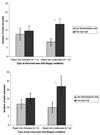Infants use attention but not emotions to predict others' actions
- PMID: 20031233
- PMCID: PMC2819570
- DOI: 10.1016/j.infbeh.2009.11.003
Infants use attention but not emotions to predict others' actions
Abstract
Phillips et al. (2002) suggest that by 12-14 months, infants can use a person's emotional and attentional cues to predict that person's actions. However, this work was conducted using only positive emotions, which is problematic because attention and positive emotions lead to the same prediction about a person's actions, thus leaving unclear whether infants made predictions based upon attention and emotion or attention alone. To get around this problem, we used both positive and negative emotions in a looking-time paradigm to investigate whether 14-month-old infants can use emotional cues to predict a person's actions. The findings suggest that infants used attentional but not emotional cues as predictors. We argue that while 14-month-olds can use another person's emotion cues to modify their own behavior (as in social referencing situations), they do not yet use them robustly to predict the other's behavior.
Copyright 2009 Elsevier Inc. All rights reserved.
Figures



Similar articles
-
Infants' use of attentional cues to identify the referent of another person's emotional expression.Dev Psychol. 1998 Sep;34(5):1017-25. doi: 10.1037//0012-1649.34.5.1017. Dev Psychol. 1998. PMID: 9779747
-
The developmental origins of naïve psychology in infancy.Adv Child Dev Behav. 2009;37:55-104. doi: 10.1016/s0065-2407(09)03702-1. Adv Child Dev Behav. 2009. PMID: 19673160 Review.
-
Toddlers' understanding of peers' emotions.J Genet Psychol. 2010 Jan-Mar;171(1):35-53. doi: 10.1080/00221320903300346. J Genet Psychol. 2010. PMID: 20333894 Free PMC article. Clinical Trial.
-
The development of infant detection of inauthentic emotion.Emotion. 2014 Jun;14(3):488-503. doi: 10.1037/a0035305. Epub 2014 Feb 10. Emotion. 2014. PMID: 24512249 Free PMC article. Clinical Trial.
-
Infants' perception of expressive behaviors: differentiation of multimodal information.Psychol Bull. 1997 May;121(3):437-56. doi: 10.1037/0033-2909.121.3.437. Psychol Bull. 1997. PMID: 9136644 Review.
Cited by
-
Infants predict expressers' cooperative behavior through facial expressions.PLoS One. 2017 Oct 4;12(10):e0185840. doi: 10.1371/journal.pone.0185840. eCollection 2017. PLoS One. 2017. PMID: 28977026 Free PMC article.
-
Humans but Not Chimpanzees Vary Face-Scanning Patterns Depending on Contexts during Action Observation.PLoS One. 2015 Nov 4;10(11):e0139989. doi: 10.1371/journal.pone.0139989. eCollection 2015. PLoS One. 2015. PMID: 26535901 Free PMC article.
-
Humans and chimpanzees attend differently to goal-directed actions.Nat Commun. 2012 Feb 21;3:693. doi: 10.1038/ncomms1695. Nat Commun. 2012. PMID: 22353723
-
Cry babies and pollyannas: Infants can detect unjustified emotional reactions.Infancy. 2013 Aug 1;18(Suppl 1):E81-E96. doi: 10.1111/infa.12028. Infancy. 2013. PMID: 25071421 Free PMC article.
-
The Social Context of Infant Intention Understanding.J Cogn Dev. 2014 Jan 1;15(1):60-77. doi: 10.1080/15248372.2012.710863. J Cogn Dev. 2014. PMID: 24778577 Free PMC article.
References
-
- Cacioppo JT, Gardner WL, Berntson GG. Beyond bipolar conceptualizations and measures: The case of attitudes and evaluative space. Personality and Social Psychology Review. 1997;1:3–25. - PubMed
-
- Caron AJ, Caron RF, Antell SE. Infant understanding of containment: An affordance perceived or a relationship conceived? Developmental Psychology. 1998;24(5):620–627.
-
- Ekman P, Friesen WV. Unmasking the face: A guide to recognizing emotions from facial clues. Englewood Cliffs, NJ: Prentice-Hall; 1975.
-
- Gergely G, Egyed K, Király I. On pedagogy. Developmental Science. 2007;10(1):139–146. - PubMed
-
- Hertenstein MJ, Campos JJ. The retention effects of an adult’s emotional displays on infant behavior. Child Development. 2004;75:595–613. - PubMed
Publication types
MeSH terms
Grants and funding
LinkOut - more resources
Full Text Sources
Medical

